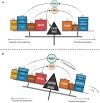From Iron Chelation to Overload as a Therapeutic Strategy to Induce Ferroptosis in Leukemic Cells
- PMID: 33042852
- PMCID: PMC7530268
- DOI: 10.3389/fonc.2020.586530
From Iron Chelation to Overload as a Therapeutic Strategy to Induce Ferroptosis in Leukemic Cells
Abstract
Despite its crucial importance in numerous physiological processes, iron also causes oxidative stress and damage which can promote the growth and proliferation of leukemic cells. Iron metabolism is strictly regulated and the related therapeutic approaches to date have been to restrict iron availability to tumor cells. However, since a new form of iron-catalyzed cell death has been described, termed ferroptosis, and subsequently better understood, iron excess is thought to represent an opportunity to selectively kill leukemic cells and spare normal hematopoietic cells, based on their differential iron needs. This review summarizes the physiology of iron metabolism and its deregulation in leukemia, the known ferrotoposis pathways, and therapeutic strategies to target the altered iron metabolism in leukemia for the purposes of initiating ferroptosis in these cancer cells.
Keywords: acute myeloid leukemia; ferritinophagy; ferroptosis; iron; reactive oxygen species.
Copyright © 2020 Grignano, Birsen, Chapuis and Bouscary.
Figures


Similar articles
-
The Clinical Significance of Iron Overload and Iron Metabolism in Myelodysplastic Syndrome and Acute Myeloid Leukemia.Front Immunol. 2021 Feb 19;11:627662. doi: 10.3389/fimmu.2020.627662. eCollection 2020. Front Immunol. 2021. PMID: 33679722 Free PMC article. Review.
-
Ferritinophagy/ferroptosis: Iron-related newcomers in human diseases.J Cell Physiol. 2018 Dec;233(12):9179-9190. doi: 10.1002/jcp.26954. Epub 2018 Aug 4. J Cell Physiol. 2018. PMID: 30076709 Review.
-
Ferroptosis: Role of lipid peroxidation, iron and ferritinophagy.Biochim Biophys Acta Gen Subj. 2017 Aug;1861(8):1893-1900. doi: 10.1016/j.bbagen.2017.05.019. Epub 2017 May 24. Biochim Biophys Acta Gen Subj. 2017. PMID: 28552631 Review.
-
[Research progress of iron metabolism and ferroptosis in myeloid neoplasms].Zhejiang Da Xue Xue Bao Yi Xue Ban. 2024 Dec 25;53(6):735-746. doi: 10.3724/zdxbyxb-2024-0211. Zhejiang Da Xue Xue Bao Yi Xue Ban. 2024. PMID: 39608794 Free PMC article. Review. Chinese.
-
Ferroptosis as a New Type of Cell Death and its Role in Cancer Treatment.Klin Onkol. 2018 Winter;31(Suppl 2):21-26. doi: 10.14735/amko20182S21. Klin Onkol. 2018. PMID: 31023020 Review. English.
Cited by
-
The Impact of Iron on Cancer-Related Immune Functions in Oncology: Molecular Mechanisms and Clinical Evidence.Cancers (Basel). 2024 Dec 13;16(24):4156. doi: 10.3390/cancers16244156. Cancers (Basel). 2024. PMID: 39766056 Free PMC article. Review.
-
Ferritinophagy, a form of autophagic ferroptosis: New insights into cancer treatment.Front Pharmacol. 2022 Oct 21;13:1043344. doi: 10.3389/fphar.2022.1043344. eCollection 2022. Front Pharmacol. 2022. PMID: 36339539 Free PMC article. Review.
-
Ferroptosis: Potential therapeutic targets and prognostic predictions for acute myeloid leukemia (Review).Oncol Lett. 2024 Sep 30;28(6):574. doi: 10.3892/ol.2024.14707. eCollection 2024 Dec. Oncol Lett. 2024. PMID: 39397802 Free PMC article. Review.
-
Dialogue between programmed cell death and psoriasis.Postepy Dermatol Alergol. 2025 Feb;42(1):13-20. doi: 10.5114/ada.2024.147195. Epub 2025 Jan 29. Postepy Dermatol Alergol. 2025. PMID: 40114770 Free PMC article. Review.
-
Irisin in the modulation of bone and cartilage homeostasis: a review on osteoarthritis relief potential.Front Physiol. 2025 Apr 17;16:1570157. doi: 10.3389/fphys.2025.1570157. eCollection 2025. Front Physiol. 2025. PMID: 40313878 Free PMC article. Review.
References
Publication types
LinkOut - more resources
Full Text Sources

